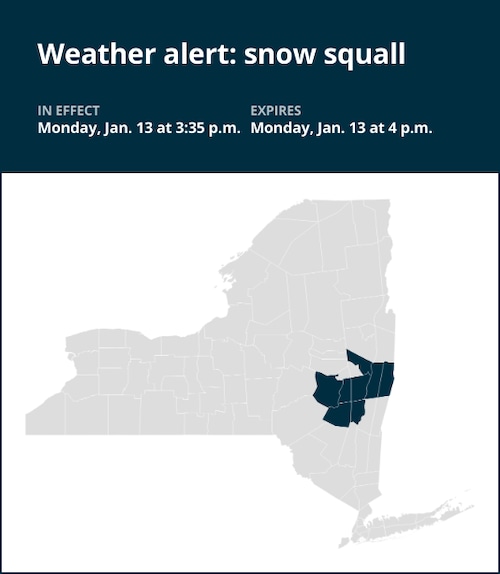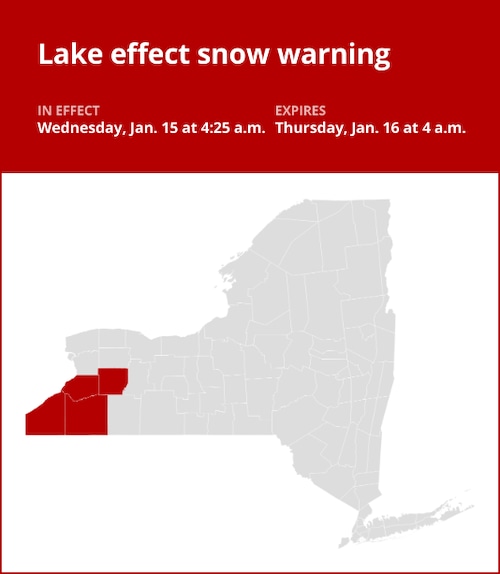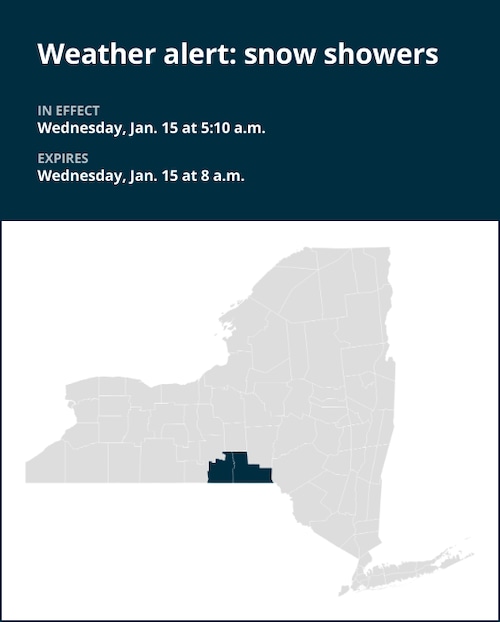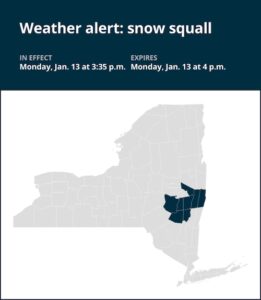At 3:35 p.m. on Monday, the National Weather Service published a forecast for Schoharie, Saratoga, Albany, Rensselaer, and Greene counties, predicting a snowstorm through 4 p.m.
“At 3:34 p.m., a snow squall was along a line extending from near Mechanicville to Loudonville to near Middleburgh and moving southeast at 15 MPH,” according to the meteorological service.
Interstate 90 between exits 10 and 24; Interstate 87 between exits 21A and 7; and Interstate 787 between exits 1 and 9 are all included in this.
The following areas are likely to experience a snow squall:
-
Albany, Troy, Cohoes, Watervliet, Rensselaer, Colonie, Delmar, Latham, Guilderland, and Menands around 3:40 p.m.
-
Feura Bush around 3:45 p.m.
-
East Greenbush, Westerlo, and West Sand Lake around 3:50 p.m.
“If you have to travel into or through this squall, exercise extra caution,” the weather agency advises. Accidents may result from abrupt changes in visibility and perhaps slick roads.
Navigating snow squalls: Understanding, preparing, and staying safe
What are snow squalls?
Strong cold fronts are frequently associated with snow squalls, which are short but intense winter weather phenomena. Even in the absence of a significant winter storm, they can quickly result in icy roads and unexpected whiteout conditions. Even while they often last less than an hour and may only cause slight snow accumulation, their reduced visibility, strong winds, and quickly dropping temperatures make them extremely dangerous for driving. In the past, these circumstances have resulted in fatal traffic accidents.
Understanding snow squalls vs. Snowstorms
The length of the event distinguishes a snowstorm from a snow squall. Typically lasting between 30 and 60 minutes, snow squalls are incredibly powerful. Days or even hours may pass during a snowfall.
Snow squall warnings
Similar to tornado and severe thunderstorm warnings, snow squall alerts are short-fused and targeted at specific locations. These alerts offer vital, extremely targeted information that can save lives. If your neighborhood is under a snow squall warning, stay indoors or postpone driving until the squall has passed.
Actions to take
When a snow squall warning is issued, people should heed the weather service’s instructions, which include the following crucial steps:
Avoid or postpone travel: If your area is under a snow squall warning, stay indoors or wait for the squall to pass through before driving. During a snowstorm, there is absolutely nowhere safe to drive on the roadway.
Reduce speed and improve visibility: If you’re already on the road during a snowstorm, put safety first by slowing down. To improve visibility for other vehicles and yourself, turn on your danger lights in addition to your headlights.
Keep a safe distance: Make sure there is enough space between your car and the one in front of you. In order to account for decreased vision and the possibility of unpredictable road conditions during a squall, this precaution is crucial.
Steer clear of quick braking: Sudden braking can cause a vehicle to lose control in icy and slippery conditions. To reduce the chance of sliding or producing a chain reaction crash, it is safer to reduce your speed gradually.
Winter weather safety advice: Go to the weather service’s Winter Weather Safety page for detailed instructions on how to keep safe before, during, and after experiencing winter weather. This website provides helpful advice and safety measures to assist you successfully deal with the difficulties presented by winter weather.
Make sure your car is ready for winter driving by checking the tires, brakes, lights, and making sure all the fluids are at the right levels before you go. A well-maintained car is better equipped to handle the challenges of winter driving.
Essentials for your car’s emergency kit: Always keep a first-aid kit, blankets, non-perishable food, water, a flashlight, and other essentials in your car’s emergency kit. For better tire traction, add jumper cables, flares or a reflective triangle, ice scraper, a map, a car cell phone charger, and cat litter or sand. Should you experience an emergency or unplanned breakdown while traveling, these supplies can be quite helpful.
In conclusion, putting one’s own safety first and following the weather service’s advice can greatly reduce dangers when a snow squall warning is in effect. People can travel through these winter dangers with more assurance and security if they are aware of them, plan beforehand, and remain alert.
United Robots offers a service called Advance Local Weather Alerts that gathers the most recent information from the National Weather Service using machine learning.







+ There are no comments
Add yours